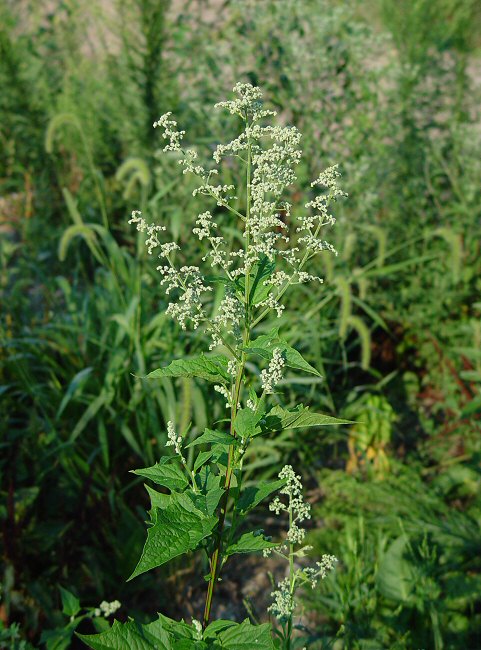Chenopodium simplex (Torr.) Raf.
Maple-Leaved Goosefoot

Native
CC = 2
CW = 5
MOC = 41
© DETenaglia
Chenopodium simplex (Torr.) Raf.Maple-Leaved Goosefoot | |
 |
Native CC = 2 CW = 5 MOC = 41 |
© DETenaglia |
|
Family - Chenopodiaceae Habit - Annual forb, lacking in strong odor. Stems - Ascending to erect, to 1.5 m, branched, glabrous or sparsely white-mealy, green.
Leaves - Simple, short- to long-petiolate. Leaf blades 3-15 cm long (the largest 7-18 cm), mostly 1.2-2.5 times as long as wide (2-9 cm wide), ovate to broadly ovate or triangular-ovate, sharply pointed at the tip, mostly rounded, truncate, or shallowly cordate at the base, green, relatively thin and herbaceous in texture, the margins with relatively few broad, coarse teeth or (in the uppermost leaves) entire to slightly wavy, the surfaces glabrous or less commonly sparsely white-mealy. Venation noticeably branched, with mostly 3 or 5 main veins.
Inflorescence - Short spikes, axillary and terminal, with small clusters of flowers, these mostly grouped into relatively large, bractless panicles. Flowers not all maturing at the same time.
Flowers - Calyx 5-lobed to below the midpoint, extending past the widest part of the fruit but not reaching the stylar area, leaving much of the portion of the fruit above the rim exposed at maturity, the lobes 0.7-1.0 mm long, lanceolate to ovate, rounded or bluntly pointed at the tip, flat to slightly rounded or narrowly and shallowly keeled dorsally, glabrous or sparsely white-mealy. Stamens 5. Stigmas 2.
Fruits - 1.5-2.5 mm wide, depressed-ovoid, the seeds positioned horizontally, the wall thin but papery, and somewhat yellowish, smooth, usually easily separated from the seed. Seeds black, shiny, smooth, bluntly angled along the rim.
Flowering - June - October. Habitat - Bottomland forests, ledges and bases of bluffs, ravines, fields, fencerows, shaded disturbed areas. Origin - Native to U.S. Lookalikes - Numerous species of Chenopodium and Amaranthus. As a group these are notoriously difficult to identify to species. Other info. - This large species can be found scattered throughout much of Missouri but is apparently absent from the southeast corner of the state. It is also distributed across most of the continental U.S., absent only from the deep South and Arizona. The plant can be identified by its rounded to cordate leaf bases, acuminate leaf tips, coarsely large-toothed leaf margins, and big, flattened fruits. The covering of the fruit (the pericarp) removes easily from the seed when rubbed or scraped. Other similar species have a pericarp that is very hard to remove. The seeds of this species are also larger than most others and may have been used as a food source in ancient times, as suggested by the plant's prevalence near prehistoric shelter sites. C. simplex also has a large, essentially leafless inflorescence. Photographs taken off Missouri Bottom Rd. near the St. Louis Airport, MO., 8-7-05. |